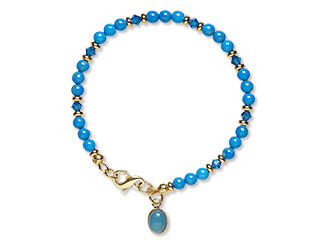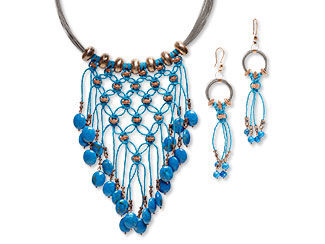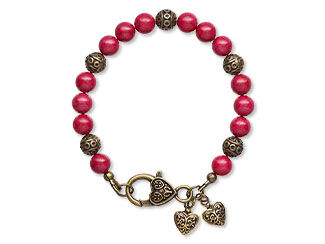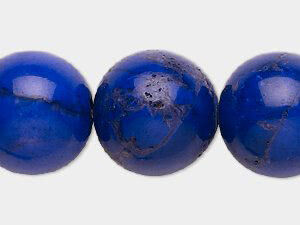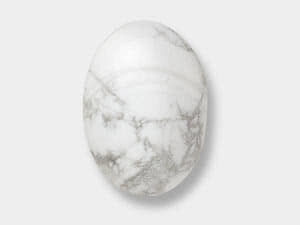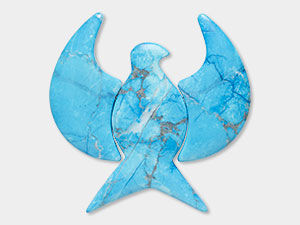Howlite Meaning and Properties
Howlite History
Cauliflower isn't the image jewelry makers usually get of raw gemstones! Howlite, however, is found in cauliflower-like masses that have the texture of unglazed porcelain. This snow-white stone is threaded with black or dark grey spiderweb veining. Some samples may have little to no veining at all.
This versatile stone is named after Henry How, a 19th century mineralogist, who found it first in Nova Scotia. While howlite can be enjoyed for its own beauty, it's most famous for the other stone it's usually tapped to stand in for: turquoise. Because howlite is soft and takes on rich hues of color when it's dyed, it becomes an inexpensive alternative to luscious lapis lazuli, cherry red coral or tantalizing turquoise. Regardless of how you use it, in its natural or dyed forms, howlite makes the most delectable looking jewelry for a price your customers will also find delectable.
What are the Metaphysical Properties of Howlite?
Undyed howlite is often believed to be an excellent stone for meditation and has been used by practitioners to focus the mind. The grey spidery veins are thought to be like intrusive thoughts, to be acknowledged and then passed by. For this mental calming effect, some believers advocate placing howlite under an insomniac's pillow, to promote serenity of mind and to empty it of distracting thought, as howlite meaning is thought to be related to placidity.
Howlite meaning is also thought to be related to relieving stress, opening up memories of previous lives and strengthening bones and/or teeth—among other benefits.
What is Howlite Made From?
Howlite is an opaque white or light grey porous stone, marked with black, grey or dark brown veining. It does not facet well but looks beautiful when carved into large shapes with curves (such as globes, eggs or skulls ) or cut en cabochon.
White (or undyed) howlite has been sold under the trade names "white turquoise," "white buffalo turquoise" and "white buffalo stone." Howlite that has been dyed turquoise blue is sometimes sold under the trade name "turquenite." Dyed howlites are sometimes coated in resin to prevent color bleeding.
Howlite can be found not only in Nova Scotia, Newfoundland and New Brunswick, Canada, but also in Turkey, Mexico, Germany, Russia and a range of sites in California.
- Mineral Information: Calcium-silicon borate with hydroxyl
- Chemical Composition: Ca2SiB5O9(OH)5
- Color: Soft white, grey veining (N); lapis blue, red, turquoise
- Hardness: 3-1/2 (Mohs)
- Refractive Index: 1.586 – 1.609
- Specific Gravity: 2.58 – 2.59
How Do You Clean Howlite?
Howlite is a soft stone, so it can easily be scratched. With its calcium structure, it is also vulnerable to many chemical cleaners, acidic perspiration and damage from sand and dust. To clean howlite, use lukewarm, slightly soapy water and a soft cloth (cotton is best). Rinse well to remove residue and pat dry. If your howlite is dyed, do not immerse the stone. Store howlite wrapped in soft cloth within a separate box or pouch to reduce the likelihood of damage.
Howlite FAQ
Q: What does howlite look like?
A: Natural howlite is a creamy white color with grey or black veining. When dyed, it can take on the appearance of turquoise and other gemstones.
Q: Is howlite often dyed?
A: Because of its porous nature, howlite takes on brilliant colors when dyed, making this practice a common and much appreciated one!
Q: Is howlite natural or synthetic?
A: Howlite is a natural stone.
Q: Does howlite have a porous texture?
A: The porous texture of howlite is one of its most valued properties, making it absorb brightly colored dyes to mimic turquoise, coral, lapis lazuli and other gemstones.
Designing with Howlite
Howlite in its natural state is a subtle stone for use in jewelry designs. The white-and-dark-grey coloring makes it an unassuming neutral for use with brighter colors, although the stone is sometimes showcased on its own with dark grey or black accent beads strung between larger howlite shapes.
Dyed howlite can be used to replace the stone it's been colored to replicate. Red howlite serves as an eco-friendly alternative to endangered red coral, while the blue versions can be used in pieces where adding lapis lazuli or Sleeping Beauty turquoise would be cost-prohibitive.
A Few Design Inspirations to Get You Started
Shop for Howlite
**Please note that all metaphysical or healing properties listed are collected from various sources. This information is offered as a service and not meant to treat medical conditions. Fire Mountain Gems and Beads® does not guarantee the validity of any of these statements.
How did you like this resource? Your feedback helps us provide resources that matter to you most.
Copyright Permissions
All works of authorship (articles, videos, tutorials and other creative works) are from the Fire Mountain Gems and Beads® Collection, and permission to copy is granted for non-commercial educational purposes only. All other reproduction requires written permission. For more information, please email copyrightpermission@firemtn.com.

